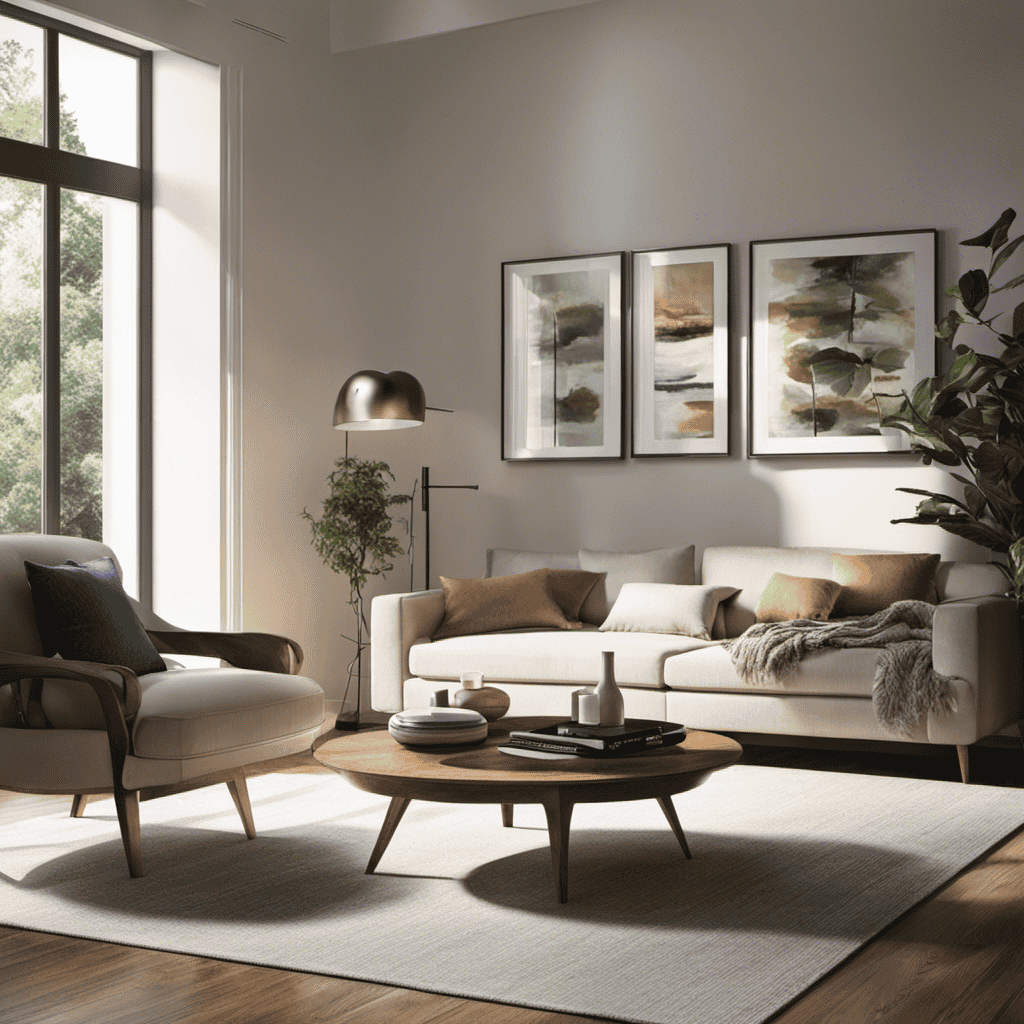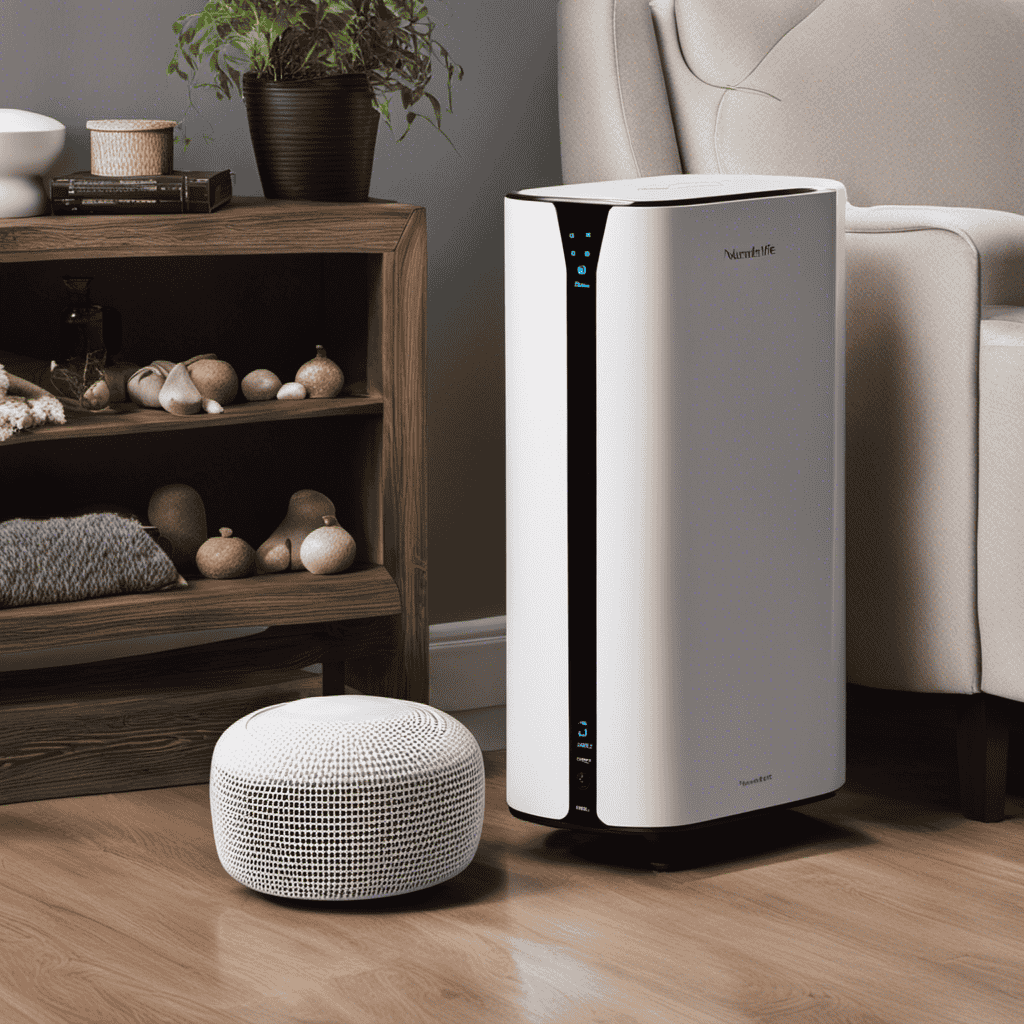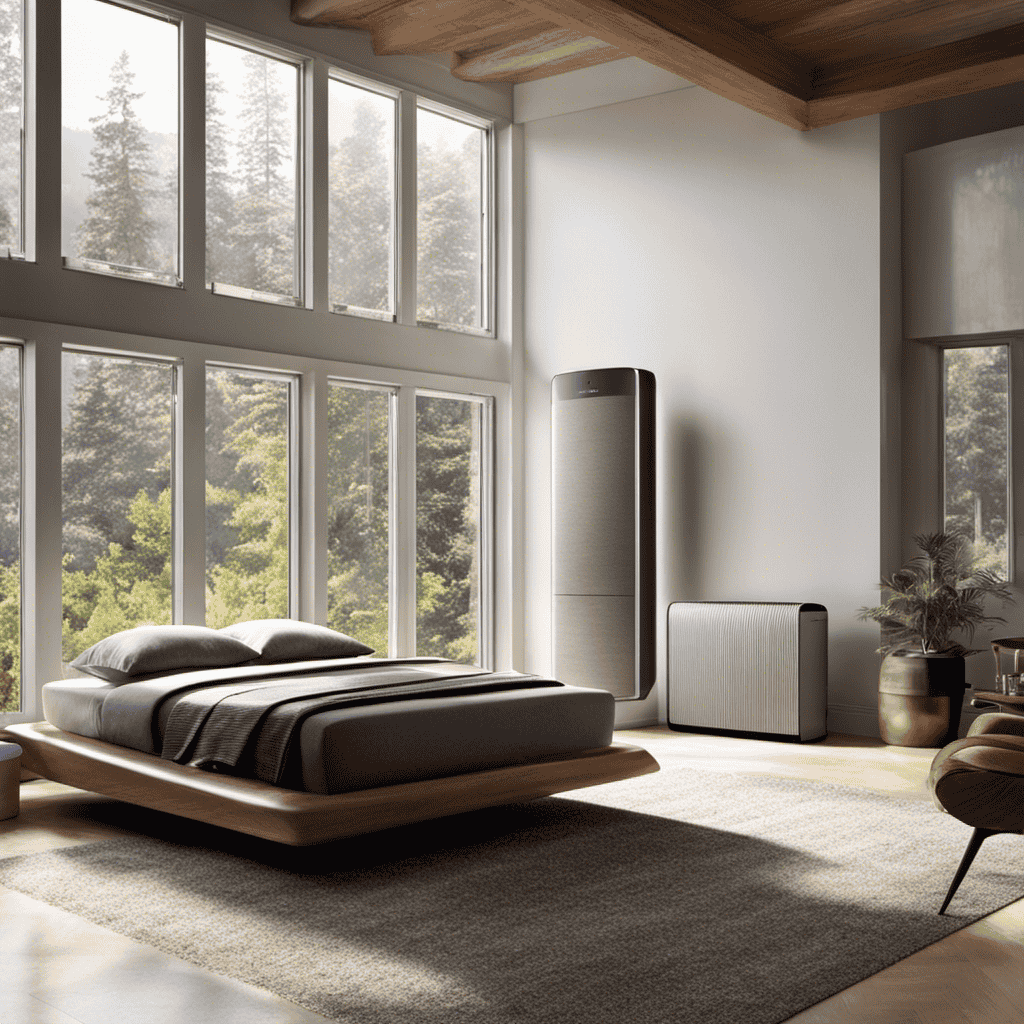As an individual who values a clean and healthy indoor space, I have always been interested in learning about the advantages of using an air purifier.
Did you know that according to the Environmental Protection Agency, indoor air can be two to five times more polluted than outdoor air? That’s where air purifiers come in. They are designed to remove common types of air pollutants, such as dust, pet dander, smoke, and odors, ensuring cleaner and healthier air for you and your loved ones.
In this article, we will explore the various uses and benefits of air purifiers in detail.
Key Takeaways
- Air purifiers improve the air quality in your home by capturing and removing harmful particles.
- They reduce the risk of allergies and respiratory issues by eliminating allergens such as pollen, dust mites, pet dander, and mold spores.
- Air purifiers alleviate symptoms of allergies and asthma by removing irritants that can inflame the airways.
- They eliminate unpleasant odors and harmful gases, creating a cleaner and fresher environment.
Benefits of Using an Air Purifier
Using an air purifier can greatly improve the air quality in your home. It makes it easier for you to breathe and reduces the risk of allergies or respiratory issues.
Air purifiers are designed to remove pollutants and contaminants from the air. These include dust, pollen, pet dander, and mold spores. They work by using filters or other mechanisms to capture and trap these particles. This prevents them from circulating in your indoor environment.
By doing so, air purifiers can help alleviate symptoms of allergies and asthma. They also improve overall respiratory health and create a cleaner and healthier living space.
Additionally, air purifiers can eliminate unpleasant odors such as cooking smells or pet odors. They also reduce the presence of harmful gases and chemicals in the air.
The advantages of using an air purifier are clear. They provide better air quality, improved respiratory health, and a more comfortable home environment.
How Does an Air Purifier Work
To understand how an air purifier works, you’ll want to know about its internal filters and how they capture and remove harmful particles from the air. Air purifiers use advanced technology to improve the quality of the air we breathe. One of the key components of an air purifier is its filters, which are designed to trap various pollutants and allergens. These filters come in different types, such as HEPA filters, activated carbon filters, and ionizers. Each type targets specific particles, ensuring cleaner air.
Here is a breakdown of the different types of filters and the pollutants they capture:
| Filter Type | Pollutants Captured |
|---|---|
| HEPA Filters | Dust, pollen, pet dander, mold spores |
| Activated Carbon Filters | Odors, chemicals, smoke |
| Ionizers | Bacteria, viruses, germs |
Regular air purifier maintenance is crucial for optimal performance. This includes cleaning or replacing filters, regularly checking the air purifier’s settings, and ensuring proper airflow. Thanks to advancements in air purifier technology, we now have more efficient and effective ways to combat indoor air pollution.
Transition Sentence: Now that you understand how an air purifier works, let’s explore the common types of air pollutants that these devices can remove.
Common Types of Air Pollutants Removed by Air Purifiers
Now that we have a better understanding of how an air purifier works, let’s delve into the various types of pollutants that can be eliminated by these devices. Air purifiers are incredibly effective at removing a wide range of contaminants from the air we breathe. Here are three common types of pollutants that can be eliminated by air purifiers:
-
Allergens: Air purifiers can capture and remove allergens such as pollen, dust mites, pet dander, and mold spores. This is especially beneficial for individuals with allergies or asthma, as it helps to reduce symptoms and improve overall respiratory health.
-
Volatile Organic Compounds (VOCs): Air purifiers equipped with activated carbon filters are capable of adsorbing VOCs, which are harmful gases emitted by household products such as cleaning supplies, paints, and furniture. By removing VOCs, air purifiers contribute to a healthier indoor environment.
-
Particulate Matter: Air purifiers are effective at capturing and filtering out fine particles, including smoke, smog, and airborne pollutants. This helps to improve air quality and reduce the risk of respiratory problems.
Regular maintenance of air purifiers is essential to ensure their optimal performance. Some maintenance tips include replacing filters as recommended by the manufacturer, cleaning the unit regularly, and keeping the surrounding area free from dust and debris.
Health Risks Associated With Poor Indoor Air Quality
Poor indoor air quality can lead to a variety of health risks, including respiratory issues and aggravated allergies. Indoor air pollution, which consists of various harmful particles and gases, can have a detrimental impact on our respiratory system.
When we breathe in polluted air, these particles can irritate and inflame our airways, leading to symptoms such as coughing, wheezing, and shortness of breath. Prolonged exposure to indoor air pollution can also increase the risk of developing respiratory diseases such as asthma, bronchitis, and chronic obstructive pulmonary disease (COPD).
These conditions can significantly affect our quality of life and may require long-term treatment and management. Therefore, it is crucial to improve indoor air quality by implementing proper ventilation, avoiding smoking indoors, and using air purifiers to filter out harmful pollutants.
Who Can Benefit From Using an Air Purifier
You can benefit from using an air purifier if you are someone who suffers from allergies or respiratory issues. Air purifiers are designed to remove pollutants and allergens from the air, providing cleaner and healthier indoor environments. Here are three reasons why air purifiers are beneficial:
-
Improved air quality: Air purifiers can effectively remove dust, pollen, pet dander, and other particles that can trigger allergies or asthma symptoms. By reducing the presence of these irritants in the air, air purifiers can help alleviate respiratory conditions and improve overall breathing.
-
Office spaces: Air purifiers are especially useful in office spaces where multiple people work together in a confined area. They can help eliminate airborne germs, bacteria, and viruses, reducing the risk of spreading illnesses and creating a healthier work environment.
-
Peace of mind: Using an air purifier can provide peace of mind for individuals with respiratory conditions, knowing that they are breathing in cleaner air. This can lead to a sense of relief and improved quality of life.
Factors to Consider When Choosing an Air Purifier
When choosing an air purifier, it’s important to consider factors such as room size, filtration system, and noise levels. These factors play a crucial role in selecting the right air purifier for your needs.
First, consider the size of the room where the air purifier will be placed. It’s essential to choose a purifier that is designed for the square footage of your space to ensure optimal performance.
Next, evaluate the filtration system of the air purifier. Look for a purifier that utilizes a high-efficiency particulate air (HEPA) filter, as it can effectively capture small particles like dust, pollen, and pet dander.
Lastly, consider the noise levels of the air purifier. Some models operate silently, while others emit noticeable noise. Selecting a purifier with a noise level that suits your preference is key.
Different Technologies Used in Air Purifiers
To choose the right air purifier for your needs, consider the various technologies employed in different models. Air purifiers have come a long way in terms of technology advancements, and understanding these advancements can help you make an informed decision.
Here are three key technologies used in air purifiers:
-
HEPA filtration: This technology uses a dense filter to trap particles as small as 0.3 microns, including allergens, dust, and pet dander. It is highly effective in improving indoor air quality.
-
Activated carbon filters: These filters are designed to absorb odors, gases, and chemicals, making them ideal for eliminating unpleasant smells and harmful volatile organic compounds (VOCs).
-
UV-C light: This technology utilizes ultraviolet light to kill bacteria, viruses, and mold spores, providing an extra layer of protection against airborne pathogens.
Understanding these technologies will help you select the air purifier that best suits your needs.
Now, let’s explore how to properly maintain an air purifier.
How to Properly Maintain an Air Purifier
Proper maintenance of an air purifier ensures optimal performance and extends its lifespan. Regular cleaning is essential to keep the air purifier functioning effectively.
The first step is to consult the manufacturer’s instructions for specific cleaning techniques. In general, the filters should be cleaned or replaced regularly. Pre-filters can be vacuumed or washed to remove large particles, while HEPA filters should be replaced according to the manufacturer’s recommendations.
Additionally, the outer casing of the air purifier should be wiped down with a damp cloth to remove dust and debris. It is important to unplug the device before cleaning and to handle the filters with care.
Understanding Air Purifier Filters and Their Importance
Understanding the importance of air purifier filters is crucial for keeping your indoor air clean and fresh. Air purifier filters play a vital role in removing pollutants and allergens from the air, ensuring that you and your loved ones breathe in healthy air. Here are three reasons why air purifier filters are essential:
-
Improved respiratory health: Clean air reduces the risk of respiratory issues such as asthma and allergies, promoting overall well-being.
-
Elimination of odors: Air purifier filters help remove unpleasant odors, leaving your home smelling fresh and clean.
-
Protection against harmful particles: Filters capture airborne particles like dust, pet dander, and mold spores, preventing them from circulating in your living space.
By regularly maintaining and replacing air purifier filters, you can enjoy the benefits of clean air, such as better sleep, increased productivity, and reduced allergy symptoms.
Now, let’s explore the best practices for using an air purifier.
Best Practices for Using an Air Purifier
One of the best practices for using an air purifier is regularly cleaning or replacing the filters. Filters are essential for trapping and removing pollutants from the air, but they can become clogged over time, reducing the effectiveness of the purifier. By maintaining clean filters, you can ensure that the air purifier continues to perform optimally in removing contaminants from your indoor environment.
In addition to filter maintenance, proper placement of the air purifier is crucial for its efficiency. The table below provides some guidelines on the best placement for your air purifier based on the type of pollutants you want to target:
| Pollutant Type | Best Placement |
|---|---|
| Dust and Allergens | Living room or bedroom |
| Smoke and Odors | Near the source of smoke or odors |
| Pet Dander | Close to areas where pets spend most of their time |
| Mold and Mildew | Damp areas such as bathrooms or basements |
Furthermore, noise levels are an important consideration when using an air purifier. Look for models with noise levels below 50 decibels for a peaceful and undisturbed environment.
Can an Air Purifier Help With Allergies
To alleviate your allergies, consider placing the air purifier in your bedroom or living room, as these areas tend to accumulate dust and allergens. An air purifier can be a powerful tool in providing relief from allergies.
Here are three ways an air purifier can benefit you:
-
Removes airborne allergens: An air purifier captures and filters out allergens such as pollen, pet dander, and dust mites, helping to reduce allergy symptoms.
-
Improves indoor air quality: Air purifiers remove harmful pollutants from the air, such as volatile organic compounds (VOCs) and smoke particles, promoting cleaner and healthier air to breathe.
-
Reduces asthma triggers: For individuals with asthma, an air purifier can help reduce triggers like mold spores and chemical irritants, leading to fewer asthma attacks.
Air Purifiers for Asthma Relief
Placing an air purifier in your home can help alleviate asthma symptoms by reducing triggers like mold spores and chemical irritants. Air purifiers for respiratory conditions are designed to filter out these particles from the air, creating a cleaner and healthier environment for those with asthma. These devices use various filtration technologies, such as HEPA filters, activated carbon filters, and ionizers, to capture and eliminate airborne pollutants.
To illustrate the effectiveness of air purifiers for allergy relief, consider the following table:
| Air Purifier Brand | Filtration Technology | Coverage Area | Price |
|---|---|---|---|
| Brand A | HEPA + Activated Carbon | 500 sq ft | $200 |
| Brand B | HEPA + Ionizer | 300 sq ft | $150 |
| Brand C | HEPA + Activated Carbon + Ionizer | 700 sq ft | $250 |
As you can see, there are options available for various room sizes and budgets. Investing in an air purifier can greatly improve the air quality in your home and provide relief from asthma symptoms.
Now, let’s explore how air purifiers can benefit pet owners.
Air Purifiers for Pet Owners
As a pet owner, I understand the importance of maintaining a clean and healthy environment for both myself and my furry friend.
One key aspect of this is ensuring that the air we breathe is free from pet dander, which can trigger allergies and respiratory issues.
In this discussion, I will explore the concept of pet-friendly air filtration and ways to effectively reduce pet dander in our homes.
Pet-Friendly Air Filtration
Keep your furry friend’s allergies in check by using an air purifier specifically designed for pet-friendly air filtration. These purifiers come with pet-friendly features that target and remove allergens and odors associated with pets.
Here are three reasons why investing in a pet-friendly air purifier is essential for both you and your beloved pet:
-
Advanced filtration technology: Pet-friendly air purifiers utilize HEPA filters that can capture even the tiniest pet dander particles, pollen, and other airborne allergens, ensuring clean and fresh air for your pet to breathe.
-
Odor elimination: These purifiers often have activated carbon filters that effectively neutralize pet odors, leaving your home smelling fresh and clean.
-
Quiet operation: Pet-friendly air purifiers are designed with noise reduction technology, ensuring a peaceful environment for your pet without causing any disturbance.
Reducing Pet Dander?
To reduce pet dander, you can groom your furry friend regularly and vacuum your home frequently.
Pet dander is a common trigger for allergies in many individuals, causing symptoms such as sneezing, itching, and congestion.
By grooming your pet regularly, you can help minimize the amount of loose hair and dander that is shed. This can be done through regular brushing and bathing, which helps remove dead skin cells and trapped dander.
Additionally, vacuuming your home frequently can help remove any dander that may have settled on surfaces or in carpets.
By reducing pet dander in your home, you can effectively manage pet-related allergies and create a more comfortable living environment.
Now, let’s explore how air purifiers can further assist in managing pet-related odors and allergies.
Air Purifiers for Smoke and Odor Removal
When it comes to air purifiers, two important factors to consider are effective odor elimination and smoke particle filtration.
Odors can be stubborn and linger in the air, but with the right air purifier, you can eliminate them efficiently.
Additionally, smoke particles can be harmful and difficult to remove, but a high-quality air purifier can effectively filter them out, ensuring cleaner and healthier air in your space.
Effective Odor Elimination
Make sure you choose an air purifier that effectively eliminates odors in your home. When it comes to getting rid of unpleasant smells, not all air purifiers are created equal. To ensure the best results, consider the following factors:
-
Activated carbon filter: This type of filter is highly effective at trapping and neutralizing odors. It works by adsorbing odorous molecules, effectively removing them from the air.
-
High CADR rating: Clean Air Delivery Rate (CADR) measures how quickly an air purifier can remove pollutants from the air. A higher CADR rating means the purifier is more efficient at eliminating odors.
-
Air exchange rate: The number of times an air purifier can completely exchange the air in a room per hour is crucial for odor elimination. Look for a purifier with a high air exchange rate to ensure effective odor removal.
Smoke Particle Filtration
Activated carbon filters are highly effective at trapping and neutralizing smoke particles, providing cleaner air in your home. Smoke particles can be a major contributor to indoor air pollution, especially for individuals who smoke or live in areas prone to wildfires. With the advancement in smoke detection technology, it is now easier to identify the presence of smoke particles in the air. By incorporating an air purifier with activated carbon filters, you can effectively remove smoke particles, along with other harmful pollutants, from your indoor environment. It is important to regularly maintain your air purifier to ensure its optimal performance. This includes cleaning or replacing the filters as recommended by the manufacturer. By doing so, you can ensure that your air purifier continues to effectively trap and neutralize smoke particles, providing you with cleaner and healthier air.
Table:
| Benefits of Activated Carbon Filters in Air Purifiers |
|---|
| Traps and neutralizes smoke particles |
| Removes other harmful pollutants |
| Improves indoor air quality |
| Reduces odors |
| Enhances overall health and well-being |
Air Purifiers for a Cleaner and Healthier Home
Air purifiers are great for creating a cleaner and healthier home environment. They remove pollutants and allergens from the air, providing numerous benefits for our well-being. Here are three reasons why you should consider using an air purifier:
-
Improved respiratory health: Air purifiers help to remove airborne particles like dust, pollen, and pet dander, reducing the risk of respiratory issues such as allergies and asthma.
-
Odor elimination: Air purifiers equipped with activated carbon filters can effectively eliminate unpleasant odors from cooking, pets, or smoke, leaving your home smelling fresh and clean.
-
Enhanced sleep quality: By filtering out airborne irritants, air purifiers can create a cleaner and more breathable sleep environment, promoting better sleep and reducing snoring.
When choosing the right air purifier, consider factors such as the size of the room, filtration technology, and noise level. Look for models with HEPA filters, which can capture particles as small as 0.3 microns. Additionally, consider the CADR (Clean Air Delivery Rate) to ensure the purifier can effectively clean the air in your space.
What Are the Benefits of Using an Air Purifier?
Air purifier uses various filters to remove pollutants, including dust, pollen, and smoke from the air. By purifying the air, it can improve indoor air quality, reduce allergy and asthma symptoms, and create a cleaner and healthier environment for you and your family.
Frequently Asked Questions
Are Air Purifiers Effective in Reducing the Spread of Viruses and Bacteria?
Yes, air purifiers are effective in reducing the spread of viruses and bacteria. They can capture and remove airborne particles, including harmful microorganisms, improving indoor air quality and promoting a healthier environment.
Can an Air Purifier Eliminate Strong Odors Like Cigarette Smoke or Cooking Smells?
Yes, an air purifier can eliminate strong odors like cigarette smoke or cooking smells. It also reduces allergens in the air, making it effective in eliminating pet odors and improving indoor air quality.
How Often Do Air Purifier Filters Need to Be Replaced?
Air purifier maintenance is crucial for efficient performance. Signs of a dirty air filter include reduced airflow and increased dust accumulation. Regularly replacing filters is recommended to ensure clean air and optimal functioning.
Can an Air Purifier Help With Respiratory Conditions Like Bronchitis or Copd?
Yes, an air purifier can help with respiratory conditions like bronchitis or COPD. Air purifiers filter out allergens and pollutants, reducing triggers for allergies and asthma. They can improve air quality and provide relief for those with respiratory issues.
Are There Any Potential Side Effects or Risks Associated With Using an Air Purifier?
Using an air purifier can have potential long-term effects and worsen indoor air quality. It’s important to consider the specific needs of your space and consult with experts before using one.
Conclusion
In conclusion, an air purifier is an essential tool for improving indoor air quality and promoting a healthier home environment. By removing common types of air pollutants such as dust, pollen, pet dander, and smoke, air purifiers help reduce the risk of respiratory problems and allergies.
With their ability to filter and purify the air, these devices provide relief for asthma sufferers and pet owners. They also effectively eliminate smoke and odor, creating a fresher and more pleasant living space.
Using an air purifier is like having a magical shield that cleanses the air, creating a harmonious atmosphere for optimal well-being.










